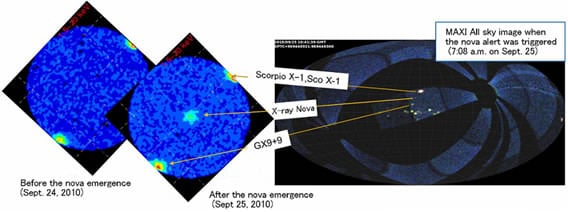[/caption]
An instrument on board the International Space Station has discovered an X-ray nova. The science team from the Monitor of All-sky X-ray Image (MAXI) instrument on the Exposed Facility of the Japanese Kibo reported a short-lived X-ray nova became visible in the constellation of Ophiuchus on September 25, 2010, and the MAXI team confirmed that it was an uncatalogued X-ray source. Astronomers say the outburst is likely to be from a binary system with a black hole. The nova was named "MAXI J1659-152, in honor of the MAXI instrument.
X-ray novas appear suddenly in the sky and dramatically increases in strength over a period of a few days and then decreases, with an overall lifetime of a few months. Sometimes, these elusive novas have an optical counterpart. Unlike a conventional nova, in which the compact component is a white dwarf, an X-ray nova may be caused by material falling onto a neutron star or a black hole.
ESA's INTEGRAL gamma-ray observatory also detected hard X-ray emission from the same position, and NASA's Swift Observatory also was alerted by the flare-up. Following the discovery, many other astronomical observatories around the world have made follow-up observations in X-ray, gamma-ray, visible, infrared, and radio wavelengths. This discovery was led by Prof. Hitoshi Nego, a member of the MAXI team.
Source:
JAXA
 Universe Today
Universe Today
